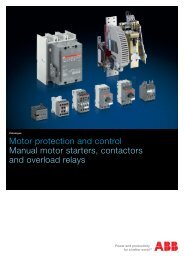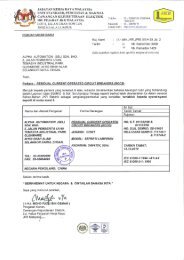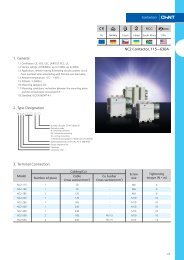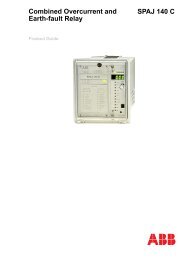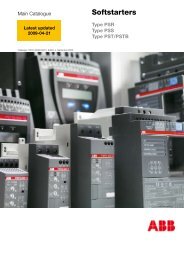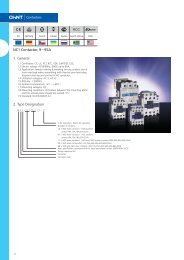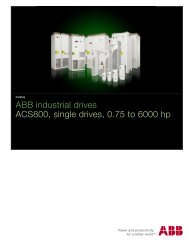- Page 2:
Main characteristicsRangesInstallat
- Page 8 and 9:
The new Emax range shines like a li
- Page 10:
Careful selection of materials, met
- Page 13 and 14:
Overview of the SACE Emax familyFie
- Page 15 and 16:
Construction characteristicsStructu
- Page 17 and 18:
Construction characteristicsOperati
- Page 19 and 20:
Construction characteristicsUtiliza
- Page 21 and 22:
Electronic trip unitsGeneral charac
- Page 23 and 24:
Electronic trip unitsVersions avail
- Page 25 and 26:
Compliance with StandardsStandards,
- Page 28 and 29:
The RangesContentsSACE Emax automat
- Page 30 and 31:
1SDC200078F00011SDC200079F00011SDC2
- Page 32 and 33:
Switch-disconnectors1SDC200060F0001
- Page 34 and 35:
Switch-disconnectors for applicatio
- Page 36 and 37:
Sectionalizing truckSectionalizing
- Page 38:
Earthing truckOther versionsEarthin
- Page 41 and 42:
Installation in switchgearModular d
- Page 43 and 44:
Installation in switchgearChoosing
- Page 45 and 46:
Installation in switchgearCurrent-c
- Page 47 and 48:
Changing the rated uninterrupted cu
- Page 49 and 50:
Changing the rated uninterrupted cu
- Page 51 and 52:
Derating at different altitudesSACE
- Page 53 and 54:
Current-limiting and specific let-t
- Page 56 and 57:
Overcurrent releases andrelated acc
- Page 58 and 59:
Operation and protection functionsP
- Page 60 and 61:
Versions availableThe following ver
- Page 62 and 63:
Functions L-I1SDC200100F00014Functi
- Page 64 and 65:
Protection trip units and trip curv
- Page 66 and 67:
Zone 3 Zone 2 Zone 1Phase unbalance
- Page 68 and 69:
Example of events indicated by the
- Page 70 and 71:
Measurement functionThe current mea
- Page 72 and 73:
Additional Protection functions and
- Page 74 and 75:
Functions L-S-It = k1SDC200111F0001
- Page 76 and 77:
Function Gt =kI 2t = k1SDC200112F00
- Page 78 and 79:
Function RVRV1SDC200125F00014Functi
- Page 80 and 81:
Notes:(1) In accordance also with I
- Page 82 and 83:
Protection functions and setting va
- Page 84 and 85:
Functions L-S-It =kI 21SDC200110F00
- Page 86 and 87:
Function LAccording to IEC 60225-3k
- Page 88 and 89:
Function UVUV1SDC200123F00014Functi
- Page 90 and 91:
Accessories for protection trip uni
- Page 92 and 93:
1SDC200129F0001SACE PR010/T configu
- Page 94 and 95:
• SD030 AO: the device acquires d
- Page 96 and 97:
Circuit-breakers with communication
- Page 98 and 99:
Measurement, signalling and availab
- Page 100 and 101:
Complete control of the installatio
- Page 104 and 105:
AccessoriesContentsFunctions of the
- Page 106 and 107:
Accessories supplied as standardThe
- Page 108 and 109:
Switch-disconnectorsSwitch-disconne
- Page 110 and 111:
1SDC200135F00011b) SOR Test UnitThe
- Page 112 and 113:
1SDC200138F00012b) Time-delay devic
- Page 114 and 115:
Signal for overcurrent releases tri
- Page 116 and 117:
1SDC200147F00015c) Electrical signa
- Page 118 and 119:
Transformers and operation counters
- Page 120 and 121:
1SDC200163F00018e) Accessory for sh
- Page 122 and 123:
Interlock between circuit-breakers1
- Page 124 and 125:
The emergency power supply is usual
- Page 126 and 127:
ATS021ATS022GeneralAuxiliary Power
- Page 130 and 131:
Applications of thecircuit-breakerC
- Page 132 and 133:
To guarantee selectivity for Emax c
- Page 134 and 135:
Double SThanks to the new PR123 tri
- Page 136 and 137:
Solution with the PR123 trip unit w
- Page 138 and 139:
The figure at the side showsthe tim
- Page 140 and 141:
To carry out the cabling, a shielde
- Page 142 and 143:
Primary and secondary distributionB
- Page 144 and 145:
By assuming some numerical values f
- Page 146 and 147:
Direction (OUT-IN)Bw ➞ BwBw ➞ F
- Page 148 and 149: Direction (OUT-IN)Fw ➞ FwFw ➞ B
- Page 150 and 151: Example of selection of earth fault
- Page 152 and 153: With the same configuration, a faul
- Page 154 and 155: Using the SACE RCQ switchboardelect
- Page 156 and 157: MV-LV substation with multipletrans
- Page 158 and 159: Switching and protection of transfo
- Page 160 and 161: Example:In an installation with Un=
- Page 162 and 163: Table for selecting circuit-breaker
- Page 164 and 165: Switching and protection of asynchr
- Page 166 and 167: WarningThe curves of the motor and
- Page 168 and 169: This protection can be carried out
- Page 170 and 171: Switching and protection of capacit
- Page 172: ABB SACE 6/436
- Page 175 and 176: Overall dimensionsFixed circuit-bre
- Page 177 and 178: Overall dimensionsFixed circuit-bre
- Page 179 and 180: Overall dimensionsFixed circuit-bre
- Page 181 and 182: Overall dimensionsWithdrawable circ
- Page 183 and 184: Overall dimensionsWithdrawable circ
- Page 185 and 186: Overall dimensionsWithdrawable circ
- Page 187 and 188: Overall dimensionsWithdrawable circ
- Page 189 and 190: 1000 max1000 maxOverall dimensionsC
- Page 191 and 192: Overall dimensionsCircuit-breaker a
- Page 193 and 194: Overall dimensionsCircuit-breaker a
- Page 196 and 197: Circuit diagramsContentsReading inf
- Page 200 and 201: NotesA) The circuit-breaker is only
- Page 202 and 203: Circuit diagramsCircuit diagram sym
- Page 204 and 205: Circuit diagramsElectrical accessor
- Page 206 and 207: Auxiliary circuits of the PR121, PR
- Page 208 and 209: HMI030(*) Connect 5 and 6 terminals
- Page 210 and 211: WITH SAFETY AUXILIARY VOLTAGE SUPPL
- Page 214 and 215: Ordering codesContentsGeneral infor
- Page 216 and 217: Ordering codesSACE Emax automatic c
- Page 218 and 219: 1SDC200259F0001PR121/P PR122/P PR12
- Page 220 and 221: 1SDC200259F0001PR121/P PR122/P PR12
- Page 222 and 223: 1SDC200259F0001PR121/P PR122/P PR12
- Page 224 and 225: 1SDC200260F0001PR121/P PR122/P PR12
- Page 226 and 227: 1SDC200260F0001PR121/P PR122/P PR12
- Page 228 and 229: 1SDC200260F0001PR121/P PR122/P PR12
- Page 230 and 231: 1SDC200260F0001PR121/P PR122/P PR12
- Page 232 and 233: 1SDC200261F0001PR121/P PR122/P PR12
- Page 234 and 235: 1SDC200262F0001PR121/P PR122/P PR12
- Page 236 and 237: Ordering codesSACE Emax automatic c
- Page 238 and 239: Ordering codesSACE Emax switch-disc
- Page 240 and 241: 1SDC200259F00011SDA......R13 Poles
- Page 242 and 243: 1SDC200260F00011SDA......R13 Poles
- Page 244 and 245: 1SDC200260F00011SDA......R13 Poles
- Page 246 and 247: 1SDC200262F00011SDA......R13 Poles
- Page 248 and 249:
1SDC200264F00011SDA......R14 PolesE
- Page 250 and 251:
1SDC200260F00011SDA......R1E3H/E 12
- Page 252 and 253:
Ordering codesSACE Emax switch-disc
- Page 254 and 255:
1SDC200260F00011SDA......R13 Poles
- Page 256 and 257:
Ordering codesSACE Emax switch-disc
- Page 258 and 259:
1SDC200260F00011SDA......R13 Poles
- Page 260 and 261:
1SDC200262F00011SDA......R13 Poles
- Page 262 and 263:
Ordering codesSACE Emax MTP earthin
- Page 264 and 265:
Ordering codesSACE Emax FP fixed pa
- Page 266 and 267:
Ordering codesConversion kit for fi
- Page 268 and 269:
Ordering codesSACE Emax accessories
- Page 270 and 271:
1SDA.....R1Electrical signalling of
- Page 272 and 273:
1SDA.....R1Circuit-breaker lock in
- Page 274 and 275:
1SDA.....R1Auxiliary unitsAutomatic
- Page 276 and 277:
Ordering codesElectronic trip units
- Page 278 and 279:
2) MechanicalinterlocksInstructions
- Page 280:
Contact usABB SACEA division of ABB




